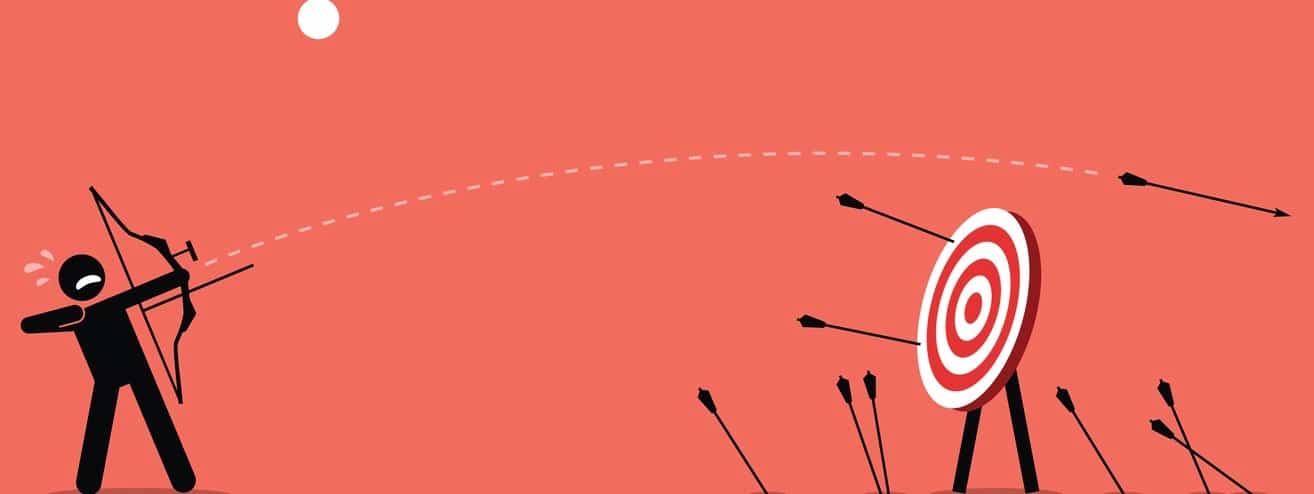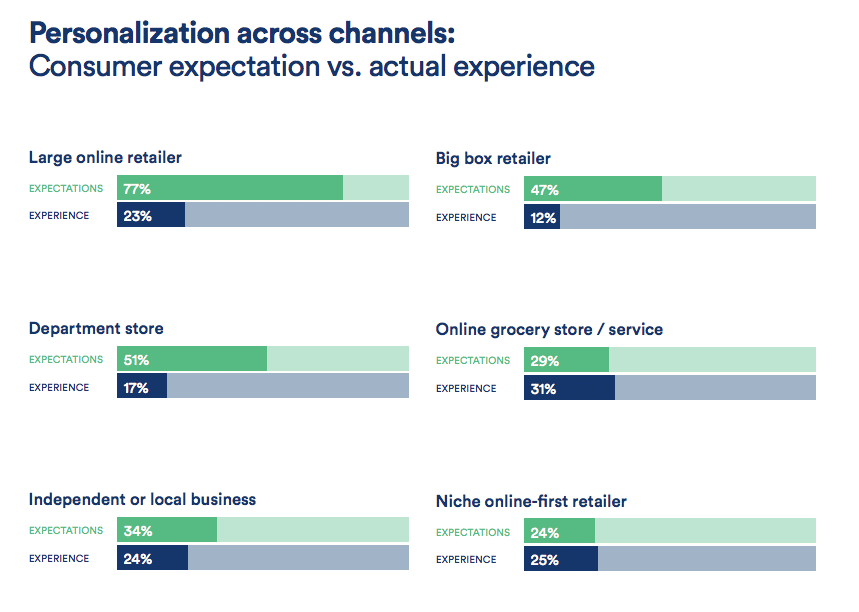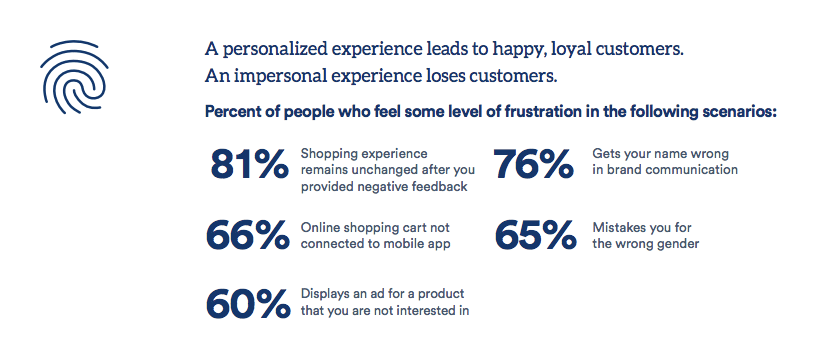With total retail sales in the United States set to hit $5.68 trillion by 2021, the competition for customers has never been more intense. Consumers expect highly personalized shopping experiences from retailers and are willing to spend more money when brands deliver targeted recommendations. But according to new research from customer data platform Segment, retailers just aren’t able to deliver the goods.
A majority of consumers are disappointed with the ongoing lack of personalization in their shopping experiences, and on average 71 percent express some level of frustration when their experience is impersonal, according to newly published The 2017 State of Personalization Report.
The proliferation of new devices and the rapidly evolving technology landscape has led to a “personalization gap” in the shopping experience, and as consumers’ expectations rise, brands are struggling to meet them. For example, 54 percent of people expect to receive a personalized discount within 24 hours of identifying themselves, and 32 percent expect a discount after just one hour. However, only 22 percent of consumers actually find their retail shopping experience to be highly personalized.
The brands who get personalization right have a lot to gain. Nearly half of shoppers surveyed (49 percent) have purchased a product they did not intend to buy after receiving a personalized recommendation from a brand. Twenty-three percent of them have spent more than $50 on a single purchase, with 7 percent spending more than $100. Notably, 85 percent of impulse buyers were happy with their purchase, and just 5 percent returned their products.
“Shoppers expect brands to remember who they are, whether they’re on a digital channel or in-store. However, very few companies can actually deliver on these tailored experiences,” says Peter Reinhardt, CEO and co-founder at Segment, in a news release. “This is a profound data and technology problem that needs to be solved. The brands who get this right will reap the rewards, as personalization and the customer experience will be the key differentiators for brands in the near future. Segment will help companies get there.”
The Personalization Gap: expectations vs. reality
The rise of multi-channel shopping has led to a “personalization gap” in the consumer experience. While small, niche retailers and grocers are in line with consumer expectations when it comes to personalization, larger, varied retailers are struggling to keep up. On average, only 22 percent of consumers find their shopping experiences to be highly personalized.
Personalization drives impulse purchases
The brands that get personalization right have a lot to gain. Whether digital or in-store, highly personalized recommendations often lead to impulse buys, and the most expensive impulse buying still happens in a brick and mortar store. Shoppers are generally happy with their impulse purchases, and only five percent will return their products.
- 49 percent of shoppers have purchased a product they did not intend to buy after receiving a personalized recommendation from a brand. 63 percent of millennials made an impulsive purchase based on a personalized recommendation.
- 40 percent of U.S. consumers say they have purchased something more expensive than planned because their experience was personalized. 23 percent have spent more than $50 on a single impulse purchase, and 22 percent of these purchases came from brick and mortar stores.
- 85 percent of consumers are satisfied with their last-minute purchases. Only 5 percent will return their products.
Personalization leads to repeat shopping
Providing tailored, personalized shopping experiences will lead to happy, loyal customers. After a personalized experience:
- 44 percent of consumers will likely become repeat buyers.
- 39 percent will be likely to tell friends or family.
- 32 percent will be like to leave a positive review.
- 22 percent will be likely to post a positive comment on social media.
Retailers must act fast
Consumer expectations are at an all-time high, and to gain loyalty and capture revenue, brands must act quickly. Olive branches of all types, but especially discounts, are most important. After identifying themselves to a brand:
- 54 percent of consumers expect to receive a relevant discount within 24 hours.
- 32 percent of consumers expect to receive a relevant discount within one hour.
- 63 percent of consumers say receiving a discount within an hour of interacting with a brand will drive loyalty.
- 45 percent say a discount is the most compelling incentive to add another item to their cart.
Retailers must improve brick-and-mortar personalization
Despite the fact that consumers in brick-and-mortar stores are willing to spend more money on unplanned purchases than through any other channel, consumers also say brick-and-mortar stores need the most improvement. Brands that work on personalizing the in-person experience have the most to gain in the coming years. The opportunity to increase loyalty — and revenue — is huge. Brick-and-mortar is the channel most likely to drive last-minute purchases worth more than $50.
- 17 percent of consumers think that retailers are customizing the in-store experience.
- 41 percent of consumers say they expect representatives in a brand’s physical store to know what they have purchased online, yet only 19 percent have experienced this.
- 24 percent of consumers think the in-store experience needs the most improvement when it comes to personalization.
The complete report detailing the findings is available here.
Segment surveyed 1,006 U.S. adults to analyze attitudes, expectations and experiences when it comes to personalized shopping, both online and in-store.







